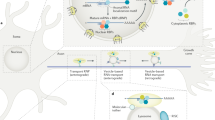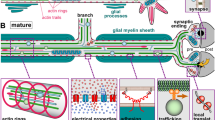Abstract
Several factors have contributed to the generally held notion that the axon depends wholly upon its cell body for all of its soluble and structural proteins. Historically, the nineteenth century experiments of Waller and Türck, demonstrating the importance of continuity between axon and cell body for preserving structural integrity of the axon, were perhaps most compelling in structuring subsequent thinking about the axon’s dependency. A second factor was the concept of axoplasmic flow, a proposed mechanism whereby the perikaryon supplies the axon with its metabolic needs. This was a logical hypothesis that followed directly from the studies involving axonal degeneration. Indeed, Barker states in his textbook published in 1899,(3): “To explain the influence of the cell body upon the fibre, Goldscheider has advanced a very ingenious hypothesis. He suggests that it is most probable that there is an actual transport of a material, perhaps a fermentlike substance, from the cell along the whole course of the axone to its extremity, and first through the influence of this chemical body the axone is enabled to make use for its nutrition of the material placed at its disposal in its anatomical course.” The phenomenon of axoplasmic flow is now well established, owing to the classic experiments of Weiss and co-workers that stimulated the large number of studies that followed subsequently (see Chapter 18, Vol. II of this Handbook).However, in view of the paucity of information at that time and the lapse of more than 40 years before the phenomenon was finally demonstrated, Goldscheider may be credited with having had profound intuitive insight.
Access this chapter
Tax calculation will be finalised at checkout
Purchases are for personal use only
Preview
Unable to display preview. Download preview PDF.
Similar content being viewed by others
References
L. Austin, J. J. Bray, and R. J. Young, Transport of proteins and ribonucleic acid along nerve axons, J. Neurochem. 13: 1267–1269 (1966).
L. Austin and I. G. Morgan, Incorporation of 14C-labelled leucine into synaptosomes from rat cerebral cortex in vitro, J. Neurochem. 14: 377–387 (1967).
L. F. Barker, The Nervous System and Its Constituent Neurones, p. 307, Appleton-CenturyCrofts, New York (1899).
S. H. Barondes, Synaptic plasticity and axoplasmic transport, Neurosci. Bull. 5: 365–370 (1967).
D. H. Clouet and H. Waelsch, Recovery of cholinesterases in the frog nervous system after inhibition, in The Regional Chemistry, Physiology and Pharmacology of the Nervous System (S. S. Kety and J. Elkes, Eds.), pp. 243–247, Pergamon Press, New York (1961).
D. H. Clouet and H. Waelsch, Amino acid and protein metabolism of the brain.—VIII. The recovery of cholinesterase in the nervous system of the frog after inhibition, J. Neurochem. 8: 201–215 (1961).
B. Droz, Rate of newly synthesized proteins in neurons, in The Use of Radioautography in Investigating Protein Synthesis (C. P. Leblond, ed.), pp. 159–175, Academic Press, New York (1965).
B. Droz and C. P. Leblond, Migration of proteins along the axons of the sciatic nerve, Science 137: 1047–1048 (1962).
B. Droz and C. P. Leblond, Axonal migration of proteins along the axons of the sciatic nerve, J. Comp. Neurol. 121: 325–345 (1963).
A. Edström, The ribonucleic acid in the Mauthner neuron of the goldfish, J. Neurochem. 11:309–314(1964).
A. Edström, Effect of spinal cord transection on the base composition and content of RNA in the Mauthner nerve fibre of the goldfish, J. Neurochem. 11: 557–559 (1964).
A. Edström, Amino acid incorporation in isolated Mauthner nerve fibre components, J. Neurochem. 13: 315–321 (1966).
A. Edström, Inhibition of protein synthesis in Mauthner nerve fibre components by actinomycin-D, J. Neurochem. 14: 239–243 (1967).
A. Edström and J.-E. Edström, Identification and properties of RNA from Mauthner nerve fibre components of the goldfish, in Macromolecules and the Function of the Neuron (Z. Lodin and S. P. R. Rose, Eds.), pp. 103–110, Excerpta Medica, Amsterdam (1968).
J.-E. Edström, Quantitative determination of ribonucleic acid in the micro-microgram range, J. Neurochem. 3: 100–106 (1958).
J.-E. Edström, Extraction, hydrolysis and electrophoretic analysis of ribonucleic acid from microscopic tissue units (microphoresis), J. Biophys. Biochem. Cytol. 8: 39–43 (1960).
J.-E. Edström, D. Eichner, and A. Edström, The ribonucleic acid of axons and myelin sheaths from Mauthner neurons, Biochim. Biophys. Acta 61: 178–184 (1962).
M. Goldstein, Long term tissue culture of neuroblastoma.-IV. Growth differentiation and function during the development of an established line of neuroblastoma, J. Natl. Cancer Inst.,in press.
W. Grampp and J.-E. Edström, The effect of nervous activity on ribonucleic acid of the crustacean receptor neuron, J. Neurochem. 10: 725–731 (1963).
H. Grundfest, Electrophysiology and pharmacology of different components of bioelectric transducers, in Sensory Receptors, Cold Spring Harbor Symp. Quant. Biol. 30: 1–14 (1965).
H. A. Hartmann, J. Lin, and M. C. Shively, RNA of nerve cell bodies and axons after beta, beta-iminodiproprionitrile, Acta Neuropathol. 11: 275–281 (1968).
A. L. Hodgkin, A. F. Huxley, and B. Katz, Measurement of current-voltage relations in the membrane of the giant axon of Loligo, J. Physiol. (London) 116: 424–448 (1952).
A. Hughes, The development of the neural tube of the chick embryo. A study with the ultraviolet microscope, J. Embryo!. Exptl. Morpho!. 3: 305–325 (1955).
A. Hughes and L. B. Flexner, A study of the development of cerebral cortex of the foetal guinea pig by means of the ultraviolet microscope, J. Anat. (London) 90: 386–394 (1956).
B. Jakoubek and J.-E. Edström, RNA changes in the Mauthner axon and myelin sheath after increased functional activity, J. Neurochem. 12: 845–849 (1965).
E. Koenig, Synthetic mechanisms in the axon.-I. Local axonal synthesis of acetyl-. cholinesterase, J. Neurochem. 12: 343–355 (1965).
E. Koenig, Synthetic mechanisms in the axon.-II. RNA in myelin-free axons of the cat, J. Neurochem. 12: 357–361 (1965).
E. Koenig, Synthetic mechanisms in the axon.-III. Stimulation of acetylcholinesterase by actinomycin-D in the hypoglossal nerve, J. Neurochem. 14: 429–435 (1967).
E. Koenig, Synthetic mechanisms in the axon.-IV. In vitro incorporation of 3H-precursors into axonal protein and RNA, J. Neurochem. 14:437 ‘I46 (1967).
E. Koenig, Intrinsic protein synthesizing mechanisms in the axon as bases for renewal and local functional differentiation of membrane, in Macromolecules and the Function of the Neuron (Z. Lodin and S. P. R. Rose, Eds.), pp. 121–128, Excerpta Medica, Amsterdam (1968).
E. Koenig, A method for determining total protein of isolated cellular elements and corresponding tritium radioactivity, J. Cell. Biol. 38: 562–573 (1968).
E. Koenig and G. B. Koelle, Acetylcholinesterase regeneration in peripheral nerve after irreversible inactivation, Science 132: 1249–1250 (1960).
E. Koenig and G. B. Koelle, Mode of regeneration of acetylcholinesterase in cholinergic neurons following irreversible inactivation, J. Neurochem. 8: 169–188 (1961).
J. A. Nurnberger, B. Edström, and B. Lindström, A study of the ventral horn cells of the adult cat by two independent cytochemical microabsorption techniques, J. Cell. Comp. Physiol. 39: 215–251 (1952).
S. L. Palay and G. E. Palade, The fine structure of neurons, J. Biophys. Biochem. Cytol. 1: 69–88 (1955).
C. H. Sawyer, Cholinesterase in degenerating and regenerating peripheral nerve, Am. J. Ph ysiol. 146: 246–253 (1946).
K. Schaffer, Kurze Anmerkung über die morphologische Differenz des Axencylinders im Verhältnisse zu den protoplasmatischen Fortsatzen bei Nissl’s Färbung, Neurol. Centralbl. (Leipzig) 12: 849–851 (1893).
M. Singer and M. M. Salpeter, Transport of tritium-labelled 1-histidine through the Schwann and myelin sheaths into the axon of peripheral nerves, Nature 210: 1225–1227 (1966).
M. Singer and M. M. Salpeter, The transport of 3H-1-histidine through the Schwann and myelin sheath into the axon, including a reevaluation of myelin function, J. Morphol. 120: 281–315 (1966).
P. Weiss and F. Rossetti, Growth responses of opposite sign among different neuron types exposed to thyroid hormone, Proc. Natl. Acad. Sci. (U.S.) 37: 540–556 (1951).
Author information
Authors and Affiliations
Editor information
Editors and Affiliations
Rights and permissions
Copyright information
© 1969 Springer Science+Business Media New York
About this chapter
Cite this chapter
Koenig, E. (1969). Nucleic Acid and Protein Metabolism of the Axon. In: Lajtha, A. (eds) Handbook of Neurochemistry. Springer, Boston, MA. https://doi.org/10.1007/978-1-4899-7321-4_17
Download citation
DOI: https://doi.org/10.1007/978-1-4899-7321-4_17
Publisher Name: Springer, Boston, MA
Print ISBN: 978-1-4899-7301-6
Online ISBN: 978-1-4899-7321-4
eBook Packages: Springer Book Archive




